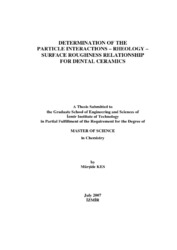Please use this identifier to cite or link to this item:
https://hdl.handle.net/11147/3832Full metadata record
| DC Field | Value | Language |
|---|---|---|
| dc.contributor.advisor | Polat, Hürriyet | en |
| dc.contributor.author | Kes, Mürşide | - |
| dc.date.accessioned | 2014-07-22T13:52:28Z | - |
| dc.date.available | 2014-07-22T13:52:28Z | - |
| dc.date.issued | 2007 | en |
| dc.identifier.uri | http://hdl.handle.net/11147/3832 | - |
| dc.description | Thesis (Master)--İzmir Institute of Technology, Chemistry, İzmir, 2007 | en |
| dc.description | Includes bibliographical references (leaves: 105-111) | en |
| dc.description | Text in English; Abstract: Turkish and English | en |
| dc.description | xiv, 111 leaves | en |
| dc.description.abstract | In this study, relationship between particle interactions, rheology and surface roughness for dental ceramics was determined. For this purpose IPS Empress 2 veneer powder was chosen and characterized with XRD, SEM, EDS, Zeta Potential and Particle Size measurements.Particle interactions have been interpreted in the light of DLVO Theory for distilled water and electrolyte solutions at different concentrations (0.1, 0.25, 0.5, 0.75,1 M NaCl and CaCl2). The results indicated that interactions between particles change with electrolyte concentration and valency. Electrical Double Layer Thickness (Debye Length) compresses and Energy Barrier height decreases as electrolyte concentration and valency increase mean that there is agglomeration between particles. In order to understand the rheological properties of the system shear rate versus shear stress and shear rate versus viscosity graphs were interpreted for the same environmental conditions, distilled water and electrolyte solutions at different concentrations. It was obtained that at low electrolyte conditions particles formed agglomerates, however at high electrolyte conditions the system reached equilibrium where particles formed gel structures due to their non-Newtonian behaviour.The results obtained from rheological measurements were compared with the results obtained from AFM, profilometer and SEM measurements for the surfaces prepared with IPS Empress 2 veneer powder and it was concluded that in the presence of electrolytes (Na+ and Ca2+) surface roughness increased at low concentrations due to agglomeration of particles whereas surface roughness decreased at high concentrations most probably due to gelation in the system. Moreover, this situation was supported with contact angle measurements where contact angle mean values are high and ditributions are wide at low electrolyte concentrations while contact angle mean values are small and distributions are narrow at high concentrations | en |
| dc.language.iso | en | en_US |
| dc.publisher | Izmir Institute of Technology | en_US |
| dc.rights | info:eu-repo/semantics/openAccess | en_US |
| dc.subject.lcc | RK655. K42 2007 | en |
| dc.subject.lcsh | Dental ceramics | en |
| dc.subject.lcsh | Rheology | en |
| dc.subject.lcsh | Surface roughness | en |
| dc.subject.lcsh | Particles | en |
| dc.title | Determination of the particle interactions -rheology- suface roughness relationship for dental ceramics | en_US |
| dc.type | Master Thesis | en_US |
| dc.institutionauthor | Kes, Mürşide | - |
| dc.department | Thesis (Master)--İzmir Institute of Technology, Chemistry | en_US |
| dc.relation.publicationcategory | Tez | en_US |
| item.fulltext | With Fulltext | - |
| item.grantfulltext | open | - |
| item.openairetype | Master Thesis | - |
| item.openairecristype | http://purl.org/coar/resource_type/c_18cf | - |
| item.languageiso639-1 | en | - |
| item.cerifentitytype | Publications | - |
| Appears in Collections: | Master Degree / Yüksek Lisans Tezleri | |
Files in This Item:
| File | Description | Size | Format | |
|---|---|---|---|---|
| T000623.pdf | MasterThesis | 5.09 MB | Adobe PDF |  View/Open |
CORE Recommender
Page view(s)
66
checked on Apr 29, 2024
Download(s)
56
checked on Apr 29, 2024
Google ScholarTM
Check
Items in GCRIS Repository are protected by copyright, with all rights reserved, unless otherwise indicated.